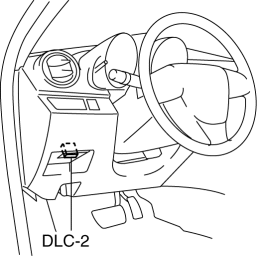Mazda 3 Service Manual: Engine Tune Up [Mzr 2.0, Mzr 2.5]
NOTE:
-
If the accelerator pedal is depressed continuously for a specified time, the engine speed may decrease to the idle speed. This is due to the fuel cut control operation, which prevents overheating, and it does not indicate a malfunction.
Engine Tune-up Preparation
1. Verify the following:
-
MTX: Shift lever is in neutral position.
-
ATX: Selector lever is in P or N position.
2. Warm up the engine to normal operating temperature.
a. Increase the engine speed to 2,500—3,000 rpm
until the cooling fan starts running.
b. When the cooling fan starts running, release the accelerator pedal and wait until the cooling fan stops running.
3. Turn off all electrical loads.
4. Connect the M-MDS to the DLC-2.

Idle Speed Inspection
NOTE:
-
Idle speed is not adjustable.
-
Idle speed verification requires M-MDS.
1. Complete the engine tune-up preparation..
2. Verify that the idle speed (M-MDS: RPM) is within the specification..
-
Idle speed (MTX: Neutral position, ATX: P, N position)
-
600—700 rpm (MTX), 650—750 (ATX)
Ignition Timing Inspection
NOTE:
-
The ignition timing cannot be adjusted.
-
The M-MDS is required to verify the ignition timing.
1. Complete the engine tune-up preparation..
2. Verify the ignition timing (M-MDS: SPARKADV) using the PID/data monitor function of the M-MDS..
-
Ignition timing
-
MZR 2.0: Approx. BTDC 8°
-
MZR 2.5: Approx. BTDC 12°
3. Verify that ignition timing advances when the engine speed increases gradually.
Idle Mixture Inspection
1. Verify that the idle speed and ignition timing are within the specification..
2. Insert an exhaust gas analyzer into the tailpipe.
3. Verify that the CO and HC concentrations are within regulation.
-
CO concentration
-
Within the regulation
-
HC concentration
-
Within the regulation
Idle-up Speed Control Inspection
NOTE:
-
Idle speed is not adjustable.
-
Idle speed verification requires M-MDS.
1. Complete the engine tune-up preparation..
2. Verify that the engine speed (M-MDS: RPM) is within the specification when each load is applied. (The speed decrease just after the load is applied is not considered.).
-
If the engine speed is not within the specification when a specified load is applied, inspect the related input parts, wiring harnesses, and connectors.
-
Idle-up speed (MTX: Neutral position, ATX: P, N position)
-
A/C on: 700—800 rpm (MTX), 650—770 (ATX)
-
Electrical loads on: 650—800 rpm
 Engine SST [Skyactiv G 2.0]
Engine SST [Skyactiv G 2.0]
1: Mazda SST number
2: Global SST number
Example
1:49 UN20 5072
2:205–072
Holder
1: –
2: 134-01049A
Evaporative emission system teste ...
 Engine Tune Up [Mzr 2.3 Disi Turbo]
Engine Tune Up [Mzr 2.3 Disi Turbo]
NOTE:
If the accelerator pedal is depressed continuously for a specified time,
the engine speed may decrease to the idle speed. This is due to the fuel cut
control operation, which preve ...
Other materials:
Interior Equipment (View A)
Door-lock knob
Turn and lane-change signal
Lighting control
Wiper and washer lever
DSC OFF switch
Tire pressure monitoring system set switch
LDWS switch
AFS OFF switch
BSM OFF switch
Headlight leveling switch
Outside mirror switch
Door-lock switch
Power window lock s ...
Vehicle Speed Sensor (VSS) Removal/Installation [FS5 A EL]
CAUTION:
If foreign materials are stuck to the sensor, disturbance by magnetic flux
can cause sensor output to be abnormal and thereby negatively affect control.
Make sure that foreign materials such as iron filings are not stuck to the sensor
during installation.
1. Perform t ...
Starter Interlock Switch Removal/Installation [C66 M R]
1. Remove the battery cover..
2. Disconnect the negative battery cable..
3. Disconnect the starter interlock switch connector.
4. Remove the starter interlock switch from the pedal bracket.
5. Insert a new starter interlock switch into the pedal bracket hole in the direction
indicated ...
